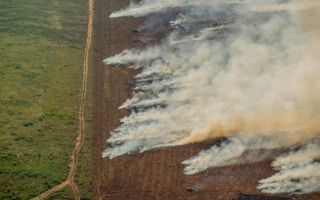Extreme events are increasingly compounding each other, even if they initially seem wide apart and unconnected, making it more crucial to tackle their root causes, says a report.
The Interconnected Disaster Risks report, by UN academic arm the United Nations University, focuses on 10 disasters worldwide in 2020-21. These include Amazon fires, floods in Vietnam, Cyclone Amphan in Bangladesh and India, and locust outbreaks across multiple countries, as well as Covid-19, and the Arctic heatwave.
“The world witnessed a number of record-breaking disasters that showed us clearer than ever before how interconnected we are,” says the report. Tackling them in “fragmented, isolated and insular ways” is no longer tenable, it adds.
While it is already known that many events are interconnected, homing in on a limited set shows the links more explicitly, says Jack O’Connor, an author of the report and senior scientist at UNU’s Institute for Environment and Human Security.
“
What we want to do with this report is to get people to see disasters more not as isolated events, but as the tip of an iceberg.
Jack O’Connor, senior scientist, UNU Institute for Environment and Human Security
“What we want to do with this report is to get people to see disasters more not as isolated events, but as the tip of an iceberg,” he said. “If you dig underneath, you find that they’re really caused by these big systems and structures that have patterns.”
Finding connections
The report highlights both the knock-on effect of one disaster on others, and similarities in root causes. The most common causes were identified as insufficient risk management and undervaluation of environmental costs in decision-making, as well as climate change.
One event covered by the report – the extinction of the Chinese paddlefish – shared similar root causes with the destruction caused by Cyclone Amphan, in that dam building in both cases had consequences for nature and people, undermining ecosystems downstream.
The paddlefish extinction also shared similarities with Amazon fires, says O’Connor, as both resulted partially from landscape interventions to harness economically valuable resources. In the case of the Amazon, trees were cut down for agriculture, resulting in declining local rainfall and worsening fires.
In turn, deforestation is linked to Western demand for meat, and has a knock-on effect on climate change, exacerbating extreme events elsewhere in the world, says the report.
“The scale of the interconnection, when you really look into it, is surprising even for us,” says O’Connor, referring to scientists studying the phenomenon.
Covid-19 has also illustrated how multiple hazards can undermine well-established measures to mitigate disasters. For example, says O’Connor, the pandemic reduced the effectiveness of early warning systems during Cyclone Amphan, complicating storm preparedness including moving people to shelters. Covid-19 also affected the ability of Vietnam to deal with last year’s floods.
Root of the problem
This all makes it important to tackle root causes in an integrated way to achieve multiple benefits rather than solving single problems, says the report.
“When you’re trying to plan for the unexpected, you have to use a systems-thinking approach,” says O’Connor. “Planning for what we’ve already seen is not going to be enough.”
He adds that these consequences are essential to consider when solutions to issues can simultaneously have highly damaging environmental effects. For example, hydropower dams, which many countries in the global South plan to build in the coming years, provide renewable energy but can also have devastating environmental impacts.
The report highlights the need to consider and mitigate “the trade-offs for clean energy, irrigation, water supply, ecosystem quality and biodiversity” in an interdisciplinary way.
Saleemul Huq, director of the International Centre for Climate Change and Development in Dhaka, Bangladesh, agrees that focusing on interconnected issues is important. “I believe that the world is now entering the era of loss and damage from human-induced climate change, and we all need to work together to deal with this issue,” he said.
In Brazil, Ane Alencar, science director at the country’s Amazon Environmental Research Institute, says a lack of political will to fight processes such as deforestation hampers the country’s ability to deal with interconnected events. “Understanding of the importance of the Amazon to Brazilians and the world, and the connection with meat consumption, food prices and other things alike is very important,” she said.
Strengthening networks for sharing prevention and response experiences between countries, and mechanisms for international cooperation and allocation of funds is critical, says Tran Si Pha, head of the disaster management department at the Vietnam Red Cross Society.
There is also a need at country level, he says, to improve the “lack of synchronisation” between localities that he says worsened the situation during Vietnam’s floods in 2020.
“Each country is a part of global development and everyone needs to join hands to deal with such international interconnected challenges,” adds Pha. “We remain optimistic and believe in the potential for cooperation between organisations and governments in the world to overcome these disasters.”
This article was originally published on SciDev.Net. Read the original article.










